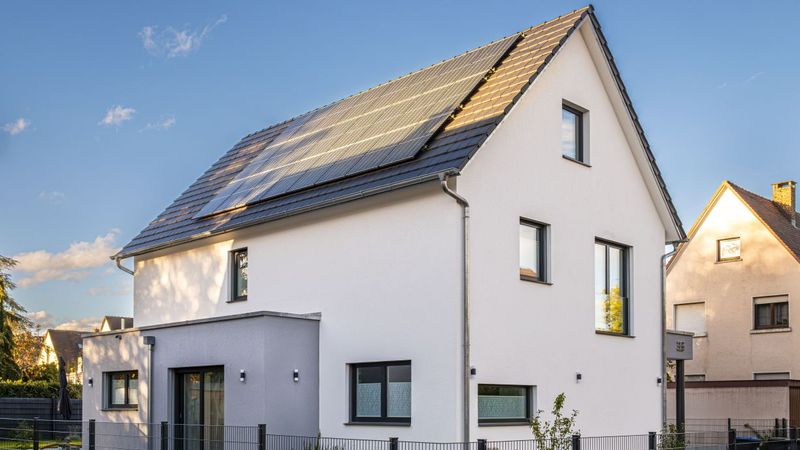Energy Turnaround: Energy Self-sufficiency in Single-Family Homes
According to calculations by KIT researchers, more than half of European single-family homes could be completely self-sufficient in energy

Ahead with solar power: Over half of European single-family homes could become energy independent. (Photo: Markus Breig, KIT)
This article was first published on
www.kit.eduPhotovoltaic systems in combination with battery storage enable more independence in energy supply. Researchers from the Karlsruhe Institute of Technology (KIT) and their partners have investigated how great the potential is for a completely self-sufficient energy supply for residential buildings. In the trade magazine Joule they show that 53 percent of single-family homes in Europe could already become technically energy self-sufficient. By 2050, more than two million buildings could leave the network through additional investments of 50 percent. (DOI: https://doi.org/10.1016/j.joule.2023.09.012 )
Electricity prices in Europe have been rising for years - after Russia's attack on Ukraine, they have now reached a record level, according to Eurostat calculations. At the same time, photovoltaics and battery storage are making it increasingly easier to become less dependent on energy suppliers. “By investing in local energy supply systems, a large part of one's own electricity consumption can be covered by oneself and thus the dependence on high electricity prices can be reduced,” says lead author Max Kleinebrahm, group leader at the Institute for Industrial Management and Industrial Production (IIP) at KIT. In Europe, building owners are increasingly opting for more independence: “In addition to economic efficiency, non-monetary aspects such as a high proportion of renewable energies, the rejection of the use of nuclear and fossil energies and a high degree of self-sufficiency also play a role in the decision increasingly important role.” A team from KIT, together with researchers from Forschungszentrum Jülich, ETH Zurich and the Paul Scherrer Institute, calculated how big the step would be from partially self-sufficient to complete self-sufficiency with electricity and heat.
How much does energy independence cost in your own home?
The basis for their calculations is a database in which geographically high-resolution information on the European building stock and the households living in them was combined with local climatic and economic conditions. By using novel methods to reduce complexity on high-performance computers, cost-optimized, energy-autonomous supply systems were initially configured for 4,000 representative single-family homes. In a further step, neural networks were then used to transfer the results to the 41 million single-family homes examined. “Under today’s conditions, 53 percent of the 41 million buildings are technically capable of powering themselves through the use of local rooftop solar radiation alone, independent of external infrastructure, and this share could rise to 75 percent by 2050 due to improved technologies,” says Professor Russell McKenna from the Swiss Federal Institute of Technology Zurich (ETH Zurich) and head of the Laboratory for Energy Systems Analysis at the Paul Scherrer Institute in Switzerland. “If you now assume that building owners would be willing to invest up to 50 percent more than would be necessary for a comparable energy system with a grid connection, then up to two million single-family homes could leave the power grid by 2050.”
The researchers see significant potential for energy self-sufficient residential buildings, especially in regions with low seasonal weather fluctuations, such as in Spain, or with high electricity prices, such as in Germany. The specific design of the cost-optimized energy systems has also been determined: “Our results show that a successful, cost-optimal and self-sufficient energy supply system for buildings in Central Europe will consist of photovoltaics to generate electricity as well as a combination of short-term battery storage and a long-term, seasonal hydrogen storage system,” says Dr. Jann Weinand, head of department at the Research Center Jülich.
More stability for the energy system
In further work, the researchers want to analyze in more detail what effects a possible large-scale spread of self-sufficient energy supply systems would have on the European energy system, but they suspect a positive effect. “Semi-autonomous residential buildings could help to stabilize the overall energy system in the future. A less pronounced demand profile from households could dampen demand for peak-load power plants,” says Elias Naber from KIT’s IIP. “However, it would then have to be prevented that building owners become completely disconnected from the grid – for example by rewarding them with special electricity tariffs for grid-friendly behavior.”
Original publication
Max Kleinebrahm, Jann Michael Weinand, Elias Naber, Russell McKenna, Armin Ardone, Wolf Fichtner: Two million European single-family homes could abandon the grid by 2050. (2023)
https://doi.org/10.1016/j.joule .2023.09.012